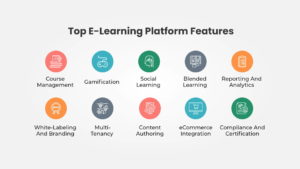E-learning platforms are revolutionary in education as they have altered the course of learning via digital mediums. In the modern world, education is no longer limited to the four walls of a classroom. It is not like this that the whole concept of education has shifted to Digital learning, but the revolutions it made. A whole new universe of learning that fits in our pockets and homes has been made possible by the development of the internet and digital tools.
Digital mediums and mobile phones are the best pair to excel in this age of countless possibilities. Previously regarded as optional, E-learning platforms are currently transforming the way we obtain information. Through these platforms, education is becoming more accessible, affordable, and flexible than ever for a wide range of learners, be they young students enrolling in virtual classes, professionals using online courses to advance their careers, or all-time learners discovering new passions.
Therefore, understanding why this change in e-learning occurring is and what is it facilitating?
The freedom to learn at your own speed, the availability of a large selection of courses, and the chance to receive instruction from top-notch instructors without regard to location are all that it has. E-learning is changing the way we think about education as it grows, combining cutting-edge technologies with age-old teaching strategies to create a more democratic and diverse body of knowledge.
E-learning platform: According to statistical analysis,

Approximately 10 million college students participated in at least one online course in 2022. Fall 2022 saw a drop in the percentage of college students enrolling in distance education courses from 75% to 54% in fall 2020, the highest during the COVID-19 pandemic. Even with this decline, online education is still very much in use. Currently, 1.1 million students attend primarily online universities, with significant demographic changes. Black students, for example, make up 23.3% of the students at these institutions, compared to 12.5% of all college students.
Financially speaking, many find Digital learning to be a cheaper alternative than traditional public universities because completely online public colleges have much lower out-of-state tuition rates.
It is anticipated that the E-learning platform market will expand by 20.5% from 2022 to 2030, owing to the growing need for adaptable and distance-learning programs.
It is important to note this change was accelerated by the COVID-19 pandemic, which made beginners become online learners very immediately. Since classes are once again held in person, a growing number of students are choosing hybrid models, which combine the convenience of online learning with the social connections and community that are essential to a college education. Furthermore, given AI’s expanding influence, higher education may undergo further evolution in the near future, bringing about even more revolutionary developments.
List of top E-learning platforms

Coursera
This learning zone Provides degrees, specializations, and courses from global colleges and businesses, such as Google, IBM, Stanford, and others.
Udemy
A platform for massively open online courses (MOOCs) offering thousands of courses on a variety of subjects, including personal development and programming.
edX
edX is an E-learning platform, that was founded by Harvard and MIT, and offers programs and courses from prestigious universities like the University of Texas, Microsoft, and Berkeley.
Khan Academy
This Digital learning platform focuses on offering students of all ages a free, excellent education with a heavy emphasis on math, science, and humanities courses.
LinkedIn Learning
It provides expert-led professional development courses in areas such as technology, business, and creative skills.
Skillshare
This is a digital platform with a creative focus that offers professional development courses in design, photography, illustration, and other fields.
FutureLearn
This learning zone offers a large selection of online degrees and short courses and collaborates with academic institutions and cultural organizations such as the British Council.
Pluralsight
It focuses on programming, cybersecurity, and data science as areas of specialization in technology and IT skills.
Udacity
Udacity, well-known for its “Nanodegree” programs, specializes in tech skills, especially in data science, programming, artificial intelligence, and autonomous systems.
Teachable
An E-learning platform that lets people and businesses make and market their own online courses in a range of areas.
The Growth of eLearning platforms

Online resources were used to supplement traditional classroom training in the early days of e-learning. At first, these platforms only had a small amount of content and were mainly meant to give students who needed more assistance further resources or lectures. However, e-learning has changed significantly in the last 20 years. What was formerly optional has evolved into a vital component of modern education.
With the introduction of broadband internet and the growing accessibility of digital devices, this change started to manifest itself. On the spur of the moment, students can access a vast array of instructional materials at anytime, anywhere.
Furthermore, with the start of digital platforms, anyone with an internet connection could now enroll in classes from esteemed universities and pick up new skills outside of the traditional classroom.
The true breakthrough in e-learning occurred during the COVID-19 epidemic in 2020. Due to the closure of colleges and universities, Digital learning became the main option for continuing education. With both teachers and students adopting live-streamed lectures, self-paced courses, and virtual classrooms, this quick shift pushed e-learning into the mainstream.
Even after switching back to in-person teaching, many institutions discovered the advantages of incorporating online learning, due to the widespread use of platforms like Zoom and Google Classroom.
How Knowledge Is Being Democratized by Benefits of E-learning

Furthermore, there are Benefits of e-learning.
- Due to its cost, accessibility, and flexibility, education has become more widely available, enabling millions of people to pursue education that best suits their needs and schedules. E-learning has become a prominent actor in the global education landscape, and its influence is only going to increase.
- With the help of eLearning, people from all walks of life can now access knowledge, shattering the barriers to education that were once in place.
- People with challenges such as remote location, budgetary limitations, or inflexible timetables can now pursue education from any location in the globe.
- People who cannot afford traditional schooling can still have possibilities because Digital learning offers a wide range of low or even free courses.
- Since access to high-quality education has always been circumscribed, developing nations are most affected by this democratization of education. Students can now access materials, degrees, and certificates from prestigious universities with simply an internet connection, leveling the playing field for many.
- The flexibility of e-learning is one of its best qualities. Online classes provide students the flexibility to learn at their own pace, in contrast to traditional classrooms that follow strict schedules.
Whether you work a full-time job or are a stay-at-home parent, e-learning can be accommodated into your schedule. This flexibility accommodates a variety of learning styles, allowing quick learners to go forward and providing more time for those who require it to fully understand complicated subjects without feeling hurried.













